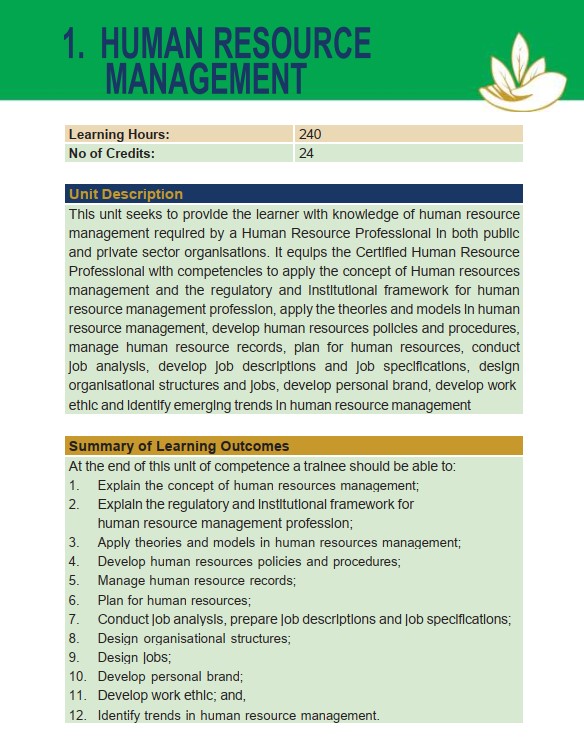
Topic Content
1. The Concept of Human Resources Management
1.1 Introduction to human resources management
1.2 Functions of human resources management
1.3 Evolution of human resources management
1.4 Models of human resources management
1.5 Principles of human resources management
1.6 Functional relationships of human resources management
1.7 Objectives of human resources management
2. Regulatory and Institutional Framework for Human Resource Management Profession
2.1 Introduction to the legal and institutional framework governing the HR profession
2.2 The Constitution
2.3 Labour Laws
2.4 Role of Ministry of Labour, IHRM, SCAC, SRC, HRMPEB
2.5 Code of conduct for HR professionals
3. Theories and Models in Human Resources Management
3.1 Organisation behaviour theory
3.2 Human capital theory
3.3 Resources-based theory
3.4 Institutional theory
3.5 Ability, motivation and opportunity theory
3.6 Transaction costs theory
3.7 The 8-Box model move talent – also consider the ppp model
3.8 Human resources management value chain model
3.9 The standard causal model of human resources management
3.10 The Harvard framework human resources model
4. Human Resources Policies and Procedures
4.1 Introduction to human resources policies and procedures
4.2 Importance of human resources management policies
4.3 Human resources management policy areas
4.4 Process of developing human resources management policies
4.5 Sources of human resources management policies and procedures
4.6 Principles of human resources management policies and procedures
4.7 Structure of human resources management policies and procedures
4.8 Implementation and review of human resource management policies and procedures
5. Human Resource Records
5.1 Introduction to human resources management records
5.2 Objectives of human resources management records
5.3 Types, essentials and precautions of creating human resources management records
5.4 Principles of good human resources management records
5.5 Creation and maintenance of employee personal files
5.6 Records life span
5.7 Methods of storing records
5.8 Record security
5.9 Data protection and access to information
5.10 Application of information technology to records management
6. Human Resource Planning
6.1 Introduction to human resources management planning
6.2 Objectives of human resources management planning
6.3 Features of human resources management planning
6.4 Process of human resources management planning
6.5 Types of human resources management plans
6.6 Building loyalty and commitment
6.7 A robust talent pipeline
6.8 Business case for human resources management plans
6.9 Challenges in human resource management planning
7. Job Descriptions and Job Specifications
7.1 Job analysis, job descriptions and job specifications Importance of job description, job specifications and job analysis
7.2 Application of job description, job specifications and job analysis
7.3 Factors of job description, job specifications and job analysis
7.4 Structure of a job description
7.5 Structure of a job analysis
7.6 Methods and techniques of conducting job analysis
7.7 Process of analysing a job
7.8 Job analysis validation
8. Design organizational structures
8.1 Introduction to organisational structure and design
8.2 Elements of organisational structure and design
8.3 Objectives of organisational structure and design
8.4 Components of organisational structure and design
8.5 Types of organisational structure and design
8.6 Components of organisational structure and design
8.7 Organisational structure and design approaches
8.8 Examples of organisational structure and design
8.9 Impact of organisational structure and design
8.10 Benefits and challenges of organisational structure and design
9. Design Jobs
9.1 Introduction to job design
9.2 Objectives of job design
9.3 Theories of job design
9.4 Types of job design
9.5 Job design approaches
9.6 Examples of job design
9.7 Techniques of job design
9.8 Impact of technology on job design
9.9 Benefits and challenges of job design
10. Employee Personal Branding
10.1 Introduction to employee personal branding
10.2 Importance of a personal branding
10.3 Elements of personal branding
10.4 Building and sustaining a personal brand
10.5 Personal brand identity
10.6 Personal brand positioning
10.7 Personal brand integrity
10.8 Personal brand mindset
10.9 The concept of employer brand
10.10 Alignment of personal branding to employer brand
10.11 Challenges in personal branding
11. Work Ethic 11.1 Introduction to work ethic
11.2 Importance of work ethic
11.3 Elements of a strong work ethic
11.4 Balancing responsibility and accountability
11.5 Developing a quality culture
11.6 Keys to self discipline
11.7 Consistency in work performance
11.8 Professionalism
11.9 Professional and self-development
11.10 Teamwork
11.11 Focus on company priorities
11.12 Managing time
11.13 Respect for others and responsibility for performance results
12. Trends in Human Resource Management and ICT applications in HRM
12.1 Attracting and retaining talent
12.2 Workforce diversity, equity and inclusion
12.3 Employer brand and value proposition
12.4 Aligning talent to the business
12.5 Artificial intelligence
12.6 Pressure to become more agile
12.7 Continual performance management culture
12.8 Data driven decision making
12.9 Virtual employee resourcing
12.10 The employee experience
12.11 Integration of generations in the organisation
12.12 Future of human resources management
12.13 Legal activism
12.14 Impact of social media
